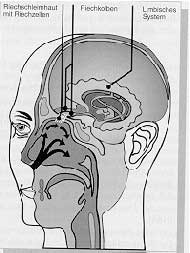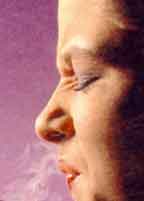Resources
Valuable resources are available for you – including NLP Practice Groups and NLP Library.
Lessons
» Eye Patterns (11)
» Anchoring I (12)
» Anchoring II (13)
Audio/Video Contributions
» Eye Access Cues
» What is an Anchor?
» Anchoring Self-Confidence
» Set Anchor
Text Articles
» Eye Access Cues
» Anchors in Everyday Life
» Smell Anchor
Success Checks
» Testing 01
» Testing 02
A strong anchor: Scents and fragrances

Scents trigger emotions, can conjure images in the mind, and bring back memories that smell like … – at Grandma's. Who doesn't know those scents that suddenly rise to the nose and instantly transport you back years or decades – unexpectedly bringing long-forgotten memories to the surface. Suddenly, Grandma's kitchen is as present as it was back then when you were seven, doing homework at her kitchen table while she cooked potato soup. It's amazing how well scents can evoke such memories – unimaginable, yet scientifically explainable.
The first station of scent perception is the olfactory mucosa in the nasal cavity. There are about three million olfactory sensory cells on an area as large as a two-euro coin. Each olfactory cell is specialized for a specific scent that triggers an electrical impulse. The extensions of the olfactory cells pass through the ethmoid bone directly into the olfactory bulb. It is located above the nasal root and is one of the oldest parts of the brain. The nose is thus the only sensory organ that directly transmits its impulses to the brain. From the olfactory bulb, nerve impulses are transmitted to the so-called olfactory brain in the cerebral cortex, where they are processed and compared with known scents. One of the pathways leads from the olfactory brain directly to the limbic system – the seat of emotions and memories.

Neuroscientists have found that when processing scents – unlike other sensory perceptions – verbal brain areas are hardly involved. This explains why it is so difficult to name scents. Also, regarding memory, there are differences: Scents that we remember are always emotionally charged. In contrast, old photos usually evoke weaker feelings.

A research group from Erlangen investigated how strongly scents influence behavior. Participants were scented with eugenol (clove oil) – this showed significant activity in the limbic system, the part of the brain responsible for emotions. Some thought of the dentist, others of Christmas. Even when they only imagined the scent, similar activity was observed.

Further studies showed that scents can influence attention. In films and tasks, the tension of the participants changed depending on the scent. For example, hexanoic acid, a substance that smells like sweat, increased tension. Scents also influence the brain during sleep – researchers from Münster found that certain scents can even change brain waves.
Interesting facts on the side

Scents are fleeting and easily mix, which complicates their research. A so-called olfactometer can be "fed" with up to six scents simultaneously and ensures uniform conditions. Materials without inherent odor must be used – glass, Teflon, and stainless steel are standard, because even plastic has a smell!







